Huawei Technologies B890-53 LTE Wireless Gateway User Manual II
Huawei Technologies Co.,Ltd LTE Wireless Gateway II
Contents
- 1. User Manual
- 2. User Manual II
User Manual II
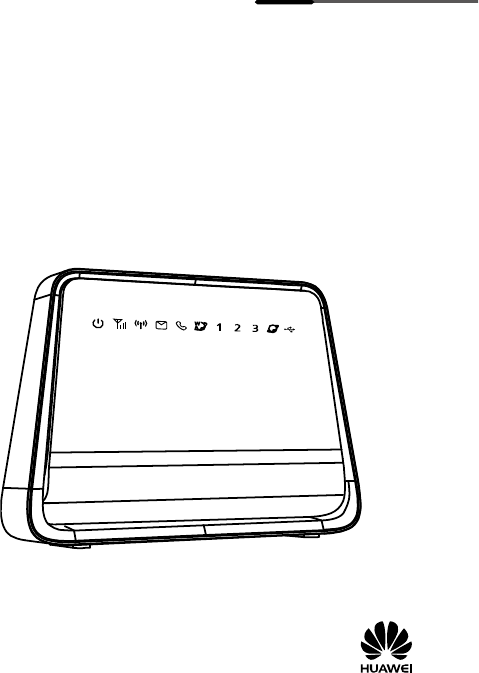
B890 LTE Wireless Gateway
Quick Start
HUAWEI TECHNOLOGIES CO., LTD.
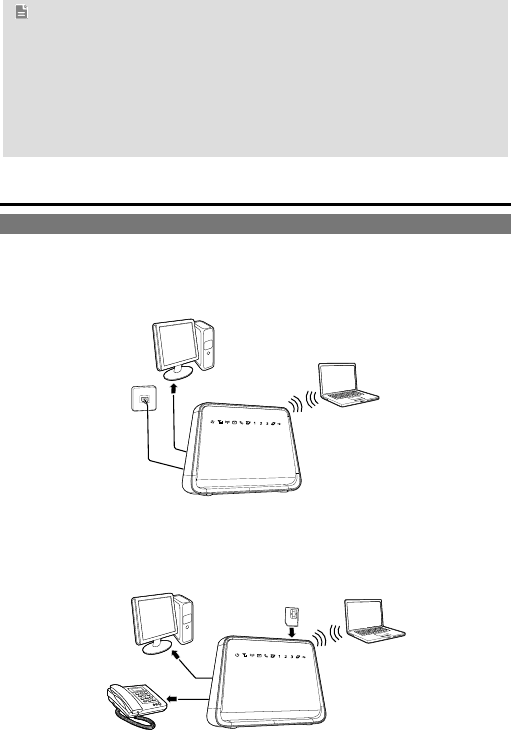
2
Note:
Figures in this guide are only for your reference. For details about a particular
model, contact your service provider.
Before purchasing this product, verify that its specifications meet your
requirements. If necessary, contact your local vendor to purchase the relevant
accessories.
This guide briefly describes the functions of the B890 LTE Wireless Gateway.
For details about how to set the management parameters, see the help
information on the web management page.
1 Getting to Know Your Device
Application Scenarios
Scenario 1:
Use an Ethernet cable to connect your B890 to an Ethernet port on the wall to
use Ethernet data services. You can also connect your computer to the B890 to
access the Internet.
Scenario 2:
Insert a Universal Subscriber Identity Module (USIM) card into your B890 to use
3G/4G data and voice services. You can also connect your computer to the B890
to access the Internet or connect a phone to it to make calls.
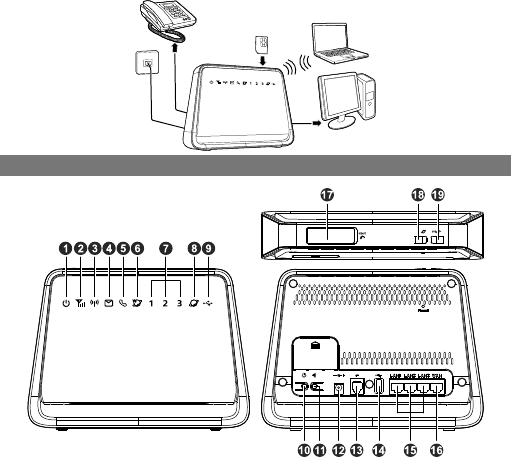
3
Scenario 3:
Use an Ethernet cable to connect your B890 to an Ethernet port on the wall to
use Ethernet data services. Then insert a USIM card into the B890 to use 3G/4G
voice services. You can also connect your computer to the B890 to access the
Internet or connect a phone to it to make calls.
Appearance
1. Power indicator
2. Network status indicator
3. Wi-Fi/WPS indicator
4. SMS indicator
5. Call status indicator
6. Wireless dialing indicator
7. LAN indicators
8. Ethernet dialing indicator
9. USB indicator
10. Power button
11. Register button (Reserved)
12. Power port
13. Telephone port
14. USB port
15. LAN ports
16. WAN port
17. USIM card slot
18. Dial-up button
19. Wi-Fi/WPS button
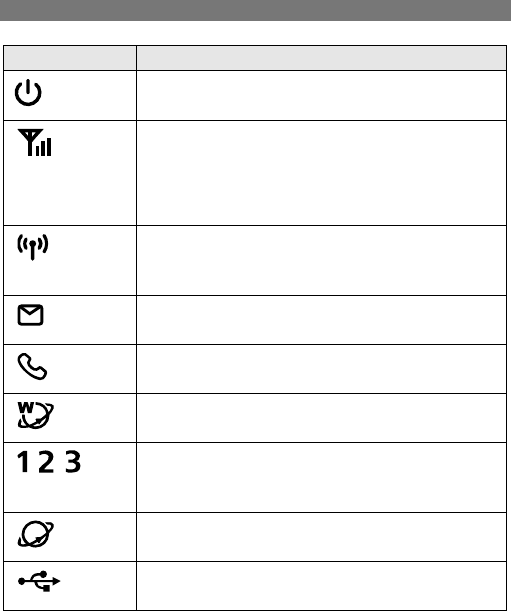
4
Indicators
The intuitive indicators on the B890 display the B890's status.
Indicator Status
On: device powered on.
Off: device powered off.
Fast red blinking: USIM card unavailable (USIM card not
installed or malfunctioning, or PIN code not verified).
Steady blue: device registered with 3G network.
Steady cyan: device registered with 4G network.
Off: no signal received.
Steady on: Wi-Fi turned on or data transfer in progress.
Blinking: WPS connection being set up.
Off: Wi-Fi turned off.
Steady on: inbox full.
Blinking: new messages.
Steady on: call in progress.
Slow blinking: incoming call.
Steady on: connected to a 3G/4G network.
Slow blinking: connecting to a 3G/4G network.
/ /
Steady on: network cable connected.
Blinking: data transfer in progress.
Off: network cable not connected.
Steady on: connected to an Ethernet network.
Slow blinking: connecting to an Ethernet network.
On: USB storage device connected.
Off: USB storage device not connected.
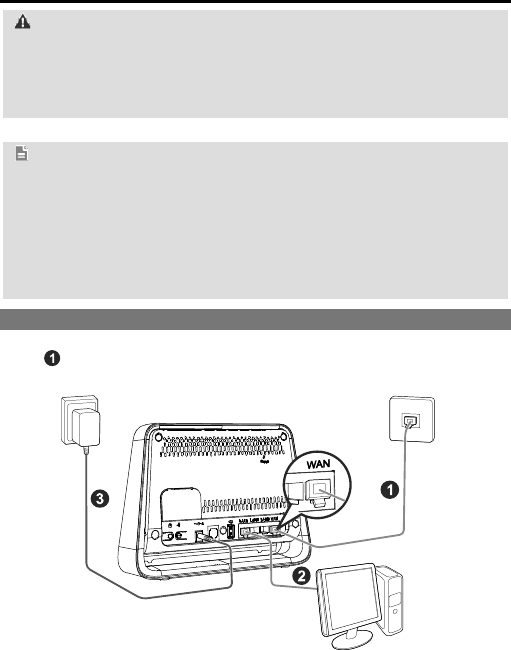
5
2 Installation
Attention:
After the B890 is installed, keep it upright, so the indicators are easy to see.
Furthermore, when placed flat, the B890 may be damaged due to poor heat
dissipation.
Only use a B890-compatible power adapter. Using an incompatible power
adapter may cause damage to the B890.
Note:
When connecting the B890 to a telephone, use an RJ11 telephone cable. Do not
connect the B890 to the telephone wall outlet (or any Public Switched Telephone
Network), because doing so could damage the B890 due to excessive heat.
Radio signals can interfere with telephone call connection and quality. To
eliminate interference, place the telephone at least 1 meter (3.28 feet) away from
the B890.
When connecting the B890 to a computer, use an RJ45 Ethernet cable no longer
than 100 meters (328 feet).
Scenario 1: Using the WAN Interface
Connect the cables in the sequence indicated in the following figure. Connect
cable to the B890's WAN port and the Ethernet port on the wall.
Once connected to a power supply, the B890 automatically powers on.
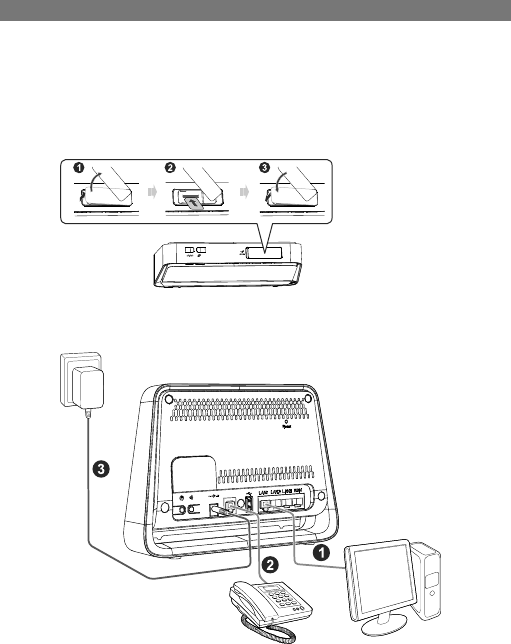
6
Scenario 2: Using the USIM Card
Step 1 Install the USIM card as follows:
1. Pull out the card slot cover and rotate it to reveal the USIM card slot.
2. Insert the USIM card into the card slot. Ensure that the beveled edge
of the USIM card aligns with that of the card slot. Gently push the
card until it clicks into place.
3. Replace the card slot cover.
Step 2 Connect the cables in the sequence indicated in the following figure.
Once connected to a power supply, the B890 automatically powers on
and searches for networks.
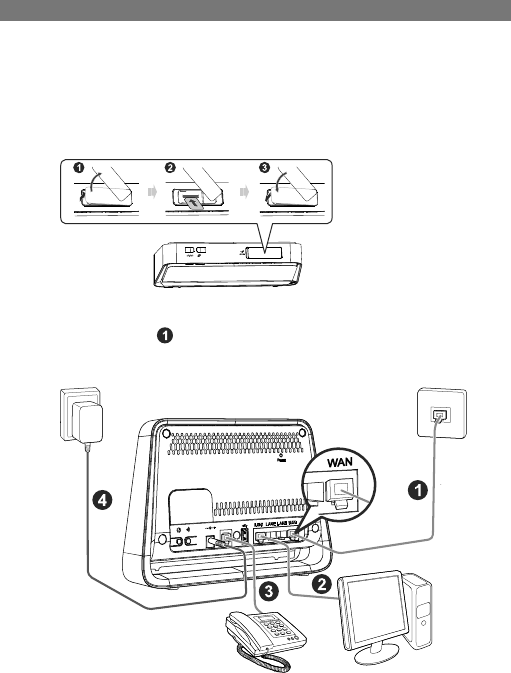
7
Scenario 3: Using the USIM Card and WAN Interface
Step 1 Install the USIM card as follows:
1. Pull out the card slot cover and rotate it to reveal the USIM card slot.
2. Insert the USIM card into the card slot. Ensure that the beveled edge
of the USIM card aligns with that of the card slot. Gently push the
card until it clicks into place.
3. Replace the card slot cover.
Step 2 Connect the cables in the sequence indicated in the following figure.
Connect cable to the B890's WAN port and the Ethernet port on
the wall.
Once connected to a power supply, the B890 automatically powers on.
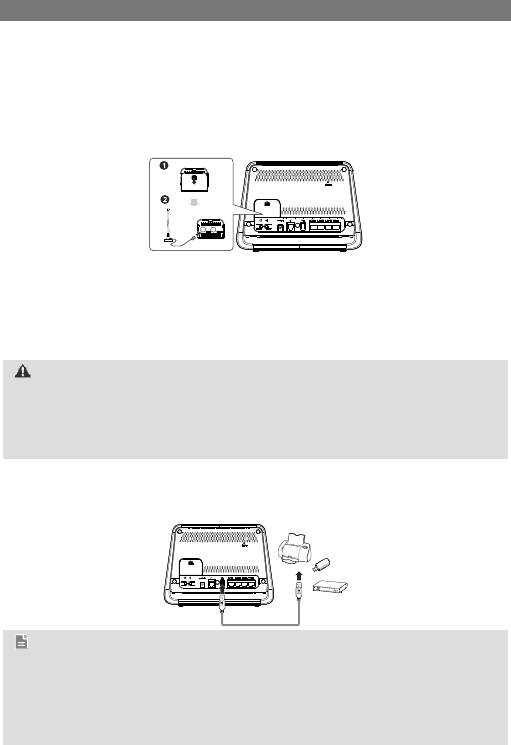
8
Advanced Scenarios: Using More Features
1. Installing an External Antenna
In areas with poor network coverage, connect an external antenna to the B890's
external antenna port for better signal reception.
Step 1 Power off the B890 and unplug the power adapter.
Step 2 Remove the cover from the antenna port. (Keep it in a safe place.)
Step 3 Screw external antenna fully into the SMA1 antenna port, as shown in
the following figure.
Step 4 If it’s necessary, screw another external antenna fully into the SMA2
antenna port to get a stronger receiving signal. And place it at least 1
meter away from the external antenna installed in step 3.
Before using external antenna, log in to the web management page
(http://192.168.1.1) and set antenna mode to outer. For details, see the help
information on the web management page.
Attention:
Do not install an external antenna to SMA2 unless there is already an external
antenna connected to SMA1. Only installing an external antenna to SMA2 will
result in your B890 not being able to connect to the internet. Only installing
external antenna to SMA1 is allowed.
Only use the external antenna indoors, and do not use it during thunderstorm.
2. Connecting to a USB device
Connect a USB device to the B890, as shown in the following figure. For details,
see the help information on the web management page.
Note:
Do not connect a computer to the B890's USB port.
B890's USB port can supply a maximum current of 500 mA. If the current
required by a peripheral device, such as a portable hard disk drive, connected to
the B890 is higher than 500 mA, the B890 may fail to recognize the device. In
this case, use an auxiliary power supply for the peripheral device. For more
information, contact your service provider.
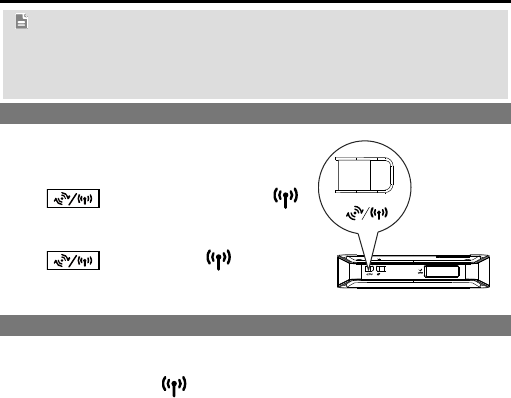
9
3 Setting Up a Wireless Connection
Note:
Before setting up a Wi-Fi connection, ensure that a wireless network adapter has
been installed on your computer. If the wireless network adapter is functioning
correctly, you will be able to find a wireless network connection in your computer's
connection manager application.
Turning the Wi-Fi On
The B890's Wi-Fi automatically turns on when
the B890 is powered on.
To manually turn Wi-Fi off, press and hold
the button for 2 seconds. The
indicator turns off.
To manually turn Wi-Fi on, press and hold
the button until the indicator
turns steady on.
Setting Up a Wi-Fi Connection Manually
A computer running Windows 7 is used as an example to describe how to
manually set up a wireless connection:
Step 1 Ensure that the indicator is steady on, and the wireless
configuration service of the computer that you want to connect is
enabled.
Step 2 Find and make note of the wireless network (SSID) and password
(Wi-Fi Key) printed on the label on the rear panel of the B890.
Step 3 Configure the wireless network connection on the computer as follows:
1. Choose Start > Control Panel > Network and Sharing Center >
Change Adapter settings.
2. In the Network Connections window, right-click the Wireless
Network Connection to display a shortcut menu, and select
Connect/Disconnect.
3. In the Wireless Network Connection dialog box, select the wireless
network whose name is the same as the one you recorded in Step 2,
and click Connect.
4. In the Connect to Network dialog box, enter the wireless network
password you recorded in Step 2, and click OK.
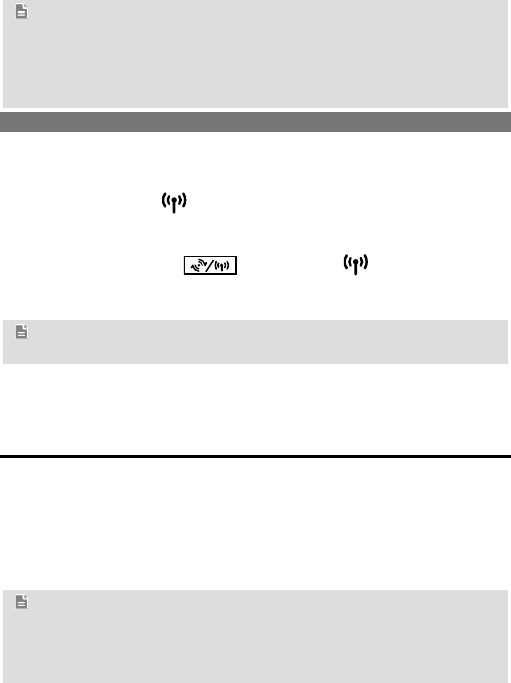
10
After the system verifies the password, Connected appears on
the wireless network icon in the wireless network list, indicating that
your computer has established a wireless connection to the B890.
Note:
If the wireless network name (SSID) and password (Wi-Fi Key) are changed, the
information will have to be reconfigured on your computer.
To protect your wireless network from unauthorized access, change the SSID
and Wi-Fi key a regular intervals. For details, see the help information on
the web management page.
Setting Up a Wi-Fi Connection Automatically
If the client to which the B890 connects supports WPS, a Wi-Fi key is generated
automatically.
To set up a WPS connection:
Step 1 Ensure that the indicator is steady on, and the wireless
configuration service of the computer that you want to connect is
enabled.
Step 2 Press and hold the button until the indicator blinks to
activate the WPS connection on your device.
Step 3 Activate the WPS connection on the client.
Note:
For details about operations on the client side, see the client user guide.
4 Logging In to the Web Management
Page
You can configure and manage the B890 settings using the web management
page.
1. Launch a web browser, and enter http://192.168.1.1 in the address bar.
2. Enter the password, and log in to the web management page. The default
password is admin.
If you are logging in to the web management page for the first time, follow the
Quick Setup Wizard to quickly configure your B890.
Note:
To protect your device, only one user can log in to the web management page at
a time.
To protect your account, change the password after the first login. For details,
see the help information on the web management page.
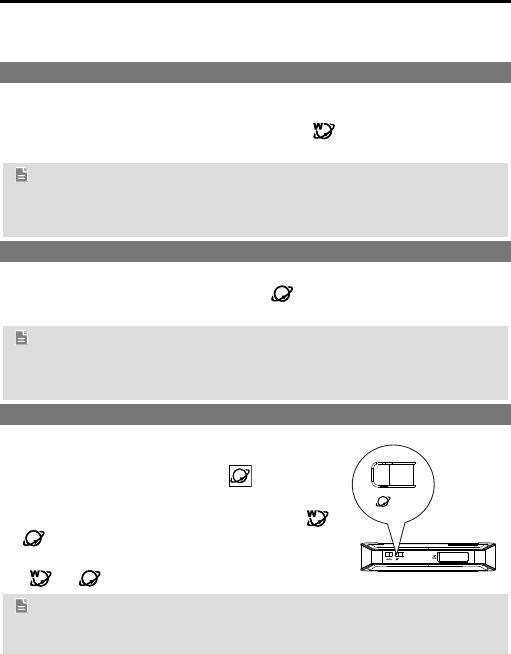
11
5 Accessing the Internet
The B890 can access the Internet through wireless networks (3G/4G networks)
and wireline networks (Ethernet networks), but it cannot access both networks
simultaneously.
Accessing a 3G/4G Wireless Network
If the USIM card is correctly installed, the B890 automatically searches for
networks after startup.
If the B890 is connected to a 3G/4G network, the indicator turns steady on.
You can then access the Internet through the 3G/4G network.
Note:
If the B890 fails to connect to the network, log in to the web management page to
verify the wireless network parameters. For details, see the help information on
the web management page.
Accessing an Ethernet Network
If the B890 is connected to the Ethernet, it automatically connects to network.
Once the B890 connects to a network, the indicator turns steady on. You
can then access the Internet through the Ethernet network.
Note:
If the B890 fails to connect to the network, log in to the web management page to
verify the wireline network parameters. For details, see the help information on
the web management page.
Accessing the Internet Manually
The B890 can access the Internet in Auto, Manual, or
On Demand mode.
In manual mode, you can press the button to
manually connect to or disconnect from the Internet.
When the B890 is connected to the Internet, the
or indicator lights up.
When the B890 is disconnected from the Internet,
the or indicator turns off.
Note:
For details about the access modes, see the help information on the web
management page.
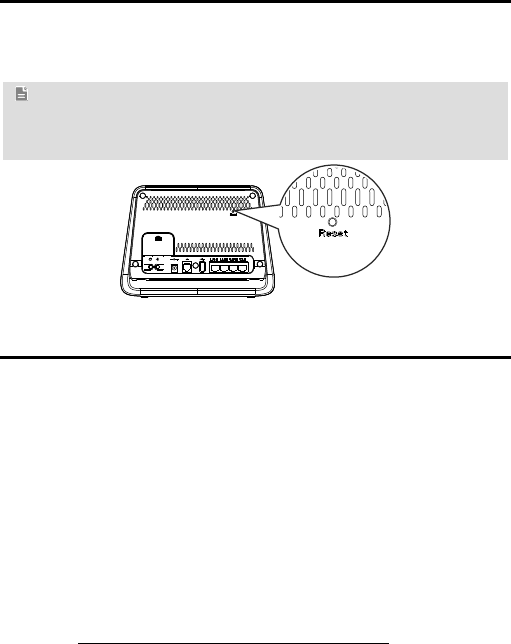
12
6 Restoring Factory Defaults
If you are uncertain of which settings you have configured or changed, you can restore
the B890’s factory defaults, and then reconfigure the B890.
To restore the factory defaults, Use a sharp-pointed object, such as a ballpoint pen, to
press and hold the RESET button until the signal indicators on the bottom blink.
Note:
After the factory defaults are restored, the B890 automatically restarts.
Restoring the factory defaults will delete all settings defined by the user and
restore all settings on the web management page to their defaults.
7 Troubleshooting Tips
If the B890 does not work properly:
See the help information on the web management page.
Restart the B890.
Restore the B890 to its factory defaults.
Contact your service provider.
Copyright © Huawei Technologies Co., Ltd. 2013. All
rights reserved.
THIS DOCUMENT IS FOR INFORMATION PURPOSES ONLY, AND DOES
NOT CONSTITUTE ANY KIND OF WARRANTIES.
Please visit www.huaweidevice.com/worldwide/support/hotline for recently
updated hotline and email address in your country or region.
96721484_02